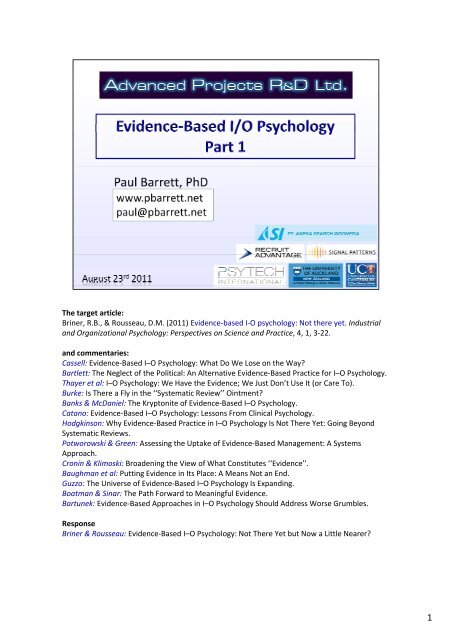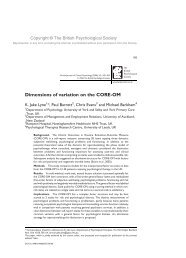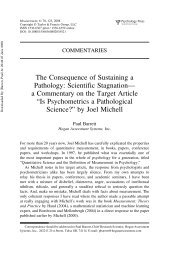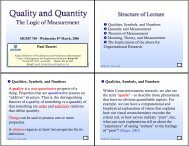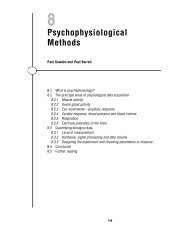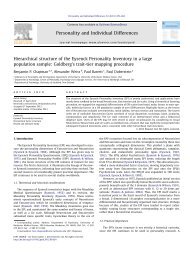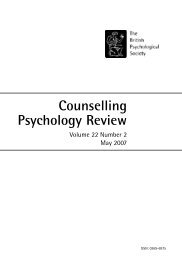Evidence-based IO psychology
Evidence-based IO psychology
Evidence-based IO psychology
You also want an ePaper? Increase the reach of your titles
YUMPU automatically turns print PDFs into web optimized ePapers that Google loves.
The target article:<br />
Briner, R.B., & Rousseau, D.M. (2011) <strong>Evidence</strong>‐<strong>based</strong> I‐O <strong>psychology</strong>: Not there yet. Industrial<br />
and Organizational Psychology: Perspectives on Science and Practice, 4, 1, 3‐22.<br />
and commentaries:<br />
Cassell: <strong>Evidence</strong>‐Based I–O Psychology: What Do We Lose on the Way<br />
Bartlett: The Neglect of the Political: An Alternative <strong>Evidence</strong>‐Based Practice for I–O Psychology.<br />
Thayer et al: I–O Psychology: We Have the <strong>Evidence</strong>; We Just Don’t Use It (or Care To).<br />
Burke: Is There a Fly in the ‘‘Systematic Review’’ Ointment<br />
Banks & McDaniel: The Kryptonite of <strong>Evidence</strong>‐Based I–O Psychology.<br />
Catano: <strong>Evidence</strong>‐Based I–O Psychology: Lessons From Clinical Psychology.<br />
Hodgkinson: Why <strong>Evidence</strong>‐Based Practice in I–O Psychology Is Not There Yet: Going Beyond<br />
Systematic Reviews.<br />
Potworowski & Green: Assessing the Uptake of <strong>Evidence</strong>‐Based Management: A Systems<br />
Approach.<br />
Cronin & Klimoski: Broadening the View of What Constitutes ‘‘<strong>Evidence</strong>’’.<br />
Baughman et al: Putting <strong>Evidence</strong> in Its Place: A Means Not an End.<br />
Guzzo: The Universe of <strong>Evidence</strong>‐Based I–O Psychology Is Expanding.<br />
Boatman & Sinar: The Path Forward to Meaningful <strong>Evidence</strong>.<br />
Bartunek: <strong>Evidence</strong>‐Based Approaches in I–O Psychology Should Address Worse Grumbles.<br />
Response<br />
Briner & Rousseau: <strong>Evidence</strong>‐Based I–O Psychology: Not There Yet but Now a Little Nearer<br />
1
Abstract<br />
<strong>Evidence</strong>‐<strong>based</strong> practice is now well established in several fields including medicine, nursing, and<br />
social policy. This article seeks to promote discussion of whether the practice of industrial–<br />
organizational (I–O) psychologists is evidence <strong>based</strong> and what is needed to make I–O <strong>psychology</strong><br />
an evidence‐<strong>based</strong> discipline. It first reviews the emergence of the concept of evidence‐<strong>based</strong><br />
practice. Second, it considers the definitions and features of evidence‐<strong>based</strong> practice, including<br />
evidence‐<strong>based</strong> management. It then assesses whether I–O <strong>psychology</strong> is itself an evidence<strong>based</strong><br />
discipline by identifying key characteristics of evidence‐<strong>based</strong> practice and judging the<br />
extent these characterize I–O <strong>psychology</strong>. py Fourth, some key strategies for promoting the use of<br />
evidence in I–O <strong>psychology</strong> are considered: practice‐oriented research and systematic reviews.<br />
Fifth, barriers to practicing evidence‐<strong>based</strong> I–O <strong>psychology</strong> are identified along with suggestions<br />
for overcoming them. Last is a look to the future of an evidence‐<strong>based</strong> I–O <strong>psychology</strong> that plays<br />
an important role in helping consultants, in‐house I–O psychologists, managers, and<br />
organizations become more evidence <strong>based</strong>.<br />
2
Practitioner expertise and judgment – relevant to dealing with Absenteeism Problem.<br />
• Have I seen this before<br />
• What happened<br />
• What are my beliefs about the causes of absence<br />
• What’s worked in the past and why<br />
• What are my hunches<br />
• What do I think are the causes and possible solutions<br />
• Is this situation occurring elsewhere<br />
• How relevant and applicable is my experience<br />
Critical evaluation of best available research evidence<br />
• What are the average rates of absence in my sector and location—Is the absence rate here ‘‘high’’<br />
• What does systematically ti reviewed research evidence suggest to be the major causes of absence<br />
• How relevant and applicable is that evidence here<br />
• What does research evidence from systematic reviews suggest as effective interventions<br />
• How well might the interventions the research describes work here<br />
<strong>Evidence</strong> from the local context<br />
• What actually is the absence rate<br />
• What type of absences and where<br />
• What are local explanations for absence<br />
• Internal research (e.g., surveys)<br />
• What absence management is currently in place, and is it working<br />
• What do managers think is going on<br />
• What are the possible costs and benefits of interventions Is it worth intervening here<br />
• What is happening or what is going to happen in the organization or outside it that might be affecting<br />
absence<br />
Perspectives of those who may be affected by the intervention decision<br />
• How do employees feel about the proposed interventions<br />
• Do they see downsides or unintended negative consequences<br />
• How do managers feel about these interventions<br />
• How practical or workable do those responsible for implementing the interventions feel<br />
• What alternative explanations and proposed solutions do others have<br />
3
1. The term ‘‘evidence <strong>based</strong>’’ is used or known. Although the general notion of using evidence<br />
is well established, the specific term ‘‘evidence‐<strong>based</strong>’’ and what it entails is not widely used<br />
or well known. It is rare to find the term ‘‘evidence <strong>based</strong>’’ paired with I–O <strong>psychology</strong> or<br />
organizational <strong>psychology</strong>.<br />
2. Systematic reviews are produced and made accessible. Although we have plenty of<br />
traditional reviews and meta‐analyses, there are very few systematic reviews in I–O<br />
<strong>psychology</strong>. S<strong>IO</strong>P is currently developing its Science You Can Use series, which will contain<br />
reviews that are not systematic as such but will go some of the way to summarizing research<br />
findings that I–O practitioners can use.<br />
3. Articles reporting gprimary research and traditional literature reviews are accessible to<br />
practitioners. We have found that this is a difficulty for many I–O <strong>psychology</strong> practitioners<br />
unless they are still attached in some way to a university. Although abstracts are easily<br />
accessible, purchasing single articles from publishers can be costly. In addition, to build up<br />
even limited knowledge of the evidence in a particular area can require access to dozens of<br />
articles, which may be prohibitively expensive. It also appears to be the case that not all I–O<br />
<strong>psychology</strong> practitioners, depending somewhat on where they trained, are highly skilled in<br />
reading and digesting (sometimes rather indigestible) journal articles.<br />
4. ‘‘Cutting‐edge’’ practices, panaceas, and fashionable ‘‘new’’ ideas are treated with healthy<br />
skepticism. i As a consequence of our training i as psychologists, we should ldbe inclined dto be<br />
quite skeptical or at least are inclined to ask about evidence and empirical support. At the<br />
same time, however, we are also somewhat drawn to what might be called management<br />
fads and fashions. Some of the recent focal articles in this journal demonstrate that we are<br />
sometimes inclined to pick up and run with the Next Big Thing even where evidence does<br />
not yet exist or is questionable. In addition, next time you attend the S<strong>IO</strong>P annual<br />
conference, check out the products and services for sale in the exhibit hall. In our<br />
experience, many of these feel more like fads than evidence‐<strong>based</strong> interventions (and often<br />
no supporting evidence is presented). One reason we pay pyattention to fads is that clients<br />
often demand the latest thing, and if we don’t deliver it, then someone else will.<br />
4
5. There is a demand for evidence‐<strong>based</strong> practice from clients and customers. Many of our major clients<br />
are those working at mid to senior levels in HRM. HRM is not a field that has embraced the notion of<br />
evidence <strong>based</strong> practice in any significant way. Although, of course, managers do not actively seek to<br />
purchase ineffective I–O <strong>psychology</strong> products or services, they are under pressure to meet certain shorter<br />
term goals. They may therefore come to depend on a general impression that particular products or<br />
techniques ‘‘work’’ rather than whether they will work in their specific context given the problem they are<br />
trying to solve. HRM departments may also lean on benchmarking or mimicry by adopting the same I–O<br />
<strong>psychology</strong> practices already used by their more successful competitors. The authors have also heard<br />
many times from I–O psychologists who say they wish to practice in an evidence‐<strong>based</strong> way but that<br />
clients have often already decided what they want (e.g., assessment centers, training programs, and<br />
employee attitude surveys) and are asking the I–O psychologist as a technical specialist to deliver it. This<br />
situation suggests that our clients are not demanding an evidence‐<strong>based</strong> approach in the sense discussed<br />
here, although h they are of course interested t din adopting practices they bli believe to be effective.<br />
6. Practice decisions are integrative and draw on the four sources of information and evidence described<br />
above. This is the most difficult characteristic of evidence‐<strong>based</strong> practice to assess without access to<br />
numerous observations of what practicing I–O psychologists actually do. In addition, it may be that as<br />
discussed above, we are not the decision makers; instead, we play an advisory role, providing information<br />
and interpretations to the decision makers... We are likely to look for and use evidence from the local<br />
context and attempt some initial assessment of the problem or situation and seek out organizational data<br />
that might help with problem diagnosis. The use of practitioner experience and judgment seems highly<br />
likely, particularly if the problem or technique is one we have encountered frequently before.<br />
7. Initial training and continuing professional development (CPD) in evidence‐ <strong>based</strong> approaches. Training<br />
in I–O <strong>psychology</strong> master’s degrees and doctorates tends to be of the fairly traditional academic variety<br />
where students are expected in a relatively passive way to learn and retain information. We note that in<br />
both the United States and Britain, the majority of practicing I–O psychologists have terminal master’s<br />
degrees. The typical master’s program in the field has no required supervised internships and does not<br />
train its students to conduct literature searches on practice topics let alone systematic reviews. The forms<br />
of CPD used by S<strong>IO</strong>P and other I–O <strong>psychology</strong> professional bodies also tend to be fairly traditional. In fact,<br />
some of these forms of CPD reverse the approach adopted by evidence‐<strong>based</strong> practice in that they<br />
present participants with recent research findings, evidence, or new techniques and then discuss how<br />
they might be used in practice rather than starting with practice problems and then searching for and<br />
evaluating the evidence that may hl help solve the problem.<br />
5
Anderson et al. (2001) noted that between 1949 and 1965, practitioners authored a full 36% of<br />
JAP articles (31% by practitioners alone). From 1990 to 2000 (the terminal year of their survey),<br />
practitioners authored only 4% of JAP articles (1% by practitioners alone). The other I–O journals<br />
manifest a similar decline. Many factors may account for this decline in practitioner research<br />
publication in our field’s journals, including a shift in journal focus to more academic topics of<br />
rigor, greater corporate concern for protecting intellectual property, as well as ramped‐up global<br />
competition and its accompanying time and resource crunch, which in turn limited practitioner<br />
opportunity for research let alone publication. One conclusion is apparent: I–O <strong>psychology</strong>’s<br />
academics and practitioners are not mingling gwith each other in our journals. Regardless of the<br />
underlying reasons, there is one serious consequence of the decline in practitioner conducted<br />
research publication: Academics are the ones asking the research questions and interpreting the<br />
answers.<br />
6
Systematic reviews are, essentially, a way of analyzing existing research using explicit and<br />
replicable methods, allowing conclusions to be drawn about what is known and what is not<br />
known in relation to the review question (and within the limitations of the method). Similar, but<br />
not identical to the traditional meta‐analysis, systematic reviews are studies of studies. Metaanalyses<br />
are a type of systematic review but one that uses only quantitative data and statistical<br />
synthesis and focuses on a question repeatedly addressed in the same way by researchers<br />
rather than a practice question or problem. As with meta‐analyses, systematic reviews are<br />
conducted out of recognition that single empirical studies, although useful and sometimes<br />
informative, should not be emphasized because their biases and limitations cannot be fully<br />
accounted for. Looking at all relevant studies, systematically gathered, constitutes more reliable<br />
evidence.<br />
Thus, in the context of evidence‐<strong>based</strong> practice, neither traditional literature reviews nor metaanalyses<br />
are especially useful. First, traditional literature reviews are open to many forms of<br />
bias. For example, reviewers do not make clear how they have selected the studies they have<br />
included, do not critically appraise them in an explicit or systematic way, and do not usually pull<br />
them together or synthesize findings across studies. Second, traditional reviews do not usually<br />
focus on a specific research, practice question, or problem. It is this latter point that also<br />
differentiates a systematic review from the quantitative meta‐analysis used traditionally in I–O<br />
<strong>psychology</strong>. The process of making evidence‐<strong>based</strong> decisions requires more focused and tailored<br />
reviews of evidence where both a practice question or problem and the conditions to which the<br />
evidence might be applied are taken into account.<br />
7
If individual managers are mostly rewarded for achieving short‐term goals as fast as possible<br />
rather than doing what works in the longer term, why would they be interested in evidence<strong>based</strong><br />
practice Perhaps, the only way to overcome this barrier is by working with organizations<br />
to demonstrate that approaching problems in an evidence <strong>based</strong> way is more likely to produce<br />
effective and sustainable solutions. It is also important to emphasize that evidence <strong>based</strong><br />
practice constitutes a family of approaches to making decisions and is not intended to provide<br />
the answer to every problem but rather improve the process and outcome of decision making.<br />
A second barrier is the predominance of master’s‐level practitioners who have learned to<br />
practice I–O <strong>psychology</strong> in unsupervised ways. Because of the level of such programs, such<br />
practitioners have a limited understanding of research, a limited capacity to access new<br />
evidence, and lack the skills to conduct their own systematic reviews let alone primary research.<br />
Collectively, we currently do not have enough of the necessary skills to widely undertake<br />
evidence‐<strong>based</strong> practice, even though our background as psychologists gives us a strong<br />
foundation on which to build. CPD that enables evidence‐<strong>based</strong> practice and helping I–O<br />
practitioners to access research evidence are two possible ways to overcome this barrier. It may<br />
also help to increase the opportunities for those qualified at the master’ss level to go on to<br />
complete doctorates.<br />
8
It can be difficult to achieve a balance between promoting a profession while at the same time<br />
acknowledging its limitations as clients may find this unnerving or see it as a sign of competence.<br />
I–O psychologists are especially challenged because other organizational consultants outside the<br />
discipline can be extremely bullish about their products and services despite their own absence<br />
of evidence. As skepticism is a key ingredient of evidence‐<strong>based</strong> practice, its limited popularity in<br />
I–O <strong>psychology</strong> is something of a barrier. One way this can be overcome is to remind ourselves<br />
that skepticism is fundamental to scientific inquiry and to any area of practice <strong>based</strong> on science.<br />
It also has the potential to clearly differentiate us from other organizational practitioners and<br />
consultants, particularly if the discipline supports practice through systematic reviews, evidence<strong>based</strong><br />
guidelines, and practice‐oriented research that contribute to more effective practice.<br />
A fourth barrier concerns the politics of evidence in organizations. Power and politics are<br />
fundamental to decision making and also surround the identification and use of evidence in<br />
organizations. Senior leaders may feel they have the right or even responsibility to make<br />
decisions <strong>based</strong> on their experience and judgment that seem to fly in the face of the available<br />
evidence. The need to be explicit in evidence‐<strong>based</strong> decision making means that those with<br />
vested interests in a particular course of action may find it more difficult to hide such interests.<br />
In general, an evidence‐<strong>based</strong> approach may prove challenging particularly in organizations with<br />
highly political cultures. Although it is impossible to remove politics from evidence and decision<br />
making, evidence‐<strong>based</strong> approaches do at least offer the possibility of making clearer<br />
distinctions among politics, values, interests, and other forms of information such as research<br />
evidence. The more decision makers are held accountable for their decisions, the more likely<br />
they are to welcome such distinctions.<br />
9
Beyond making our own practice more evidence <strong>based</strong>, we also have an important part to play in helping<br />
organizations and those who manage them become more evidence <strong>based</strong>. We envisage this could happen<br />
in several ways. First, we could provide systematic review services (or their briefer and quicker versions)<br />
to managers and organizations. These might be seen as particularly useful where the organization is trying<br />
to decide whether to invest a large sum of money in a particular intervention or program. For a fraction of<br />
the proposed program budget, we would be able to provide an objective and reasonably comprehensive<br />
review of what the published and (where available) unpublished research tells us about how effective the<br />
intervention is known to be and whether it might work here.<br />
Second, we have the skills to help organizations either make sense of their existing internal data or collect<br />
new data that might diagnose problems or show what is working and why. We believe it is not unusual,<br />
even where organizations have large quantities of data about, for example, employee behavior,<br />
performance, and attitudes, for those data to remain largely unanalyzed or subject only to the simplest<br />
and least informative analyses such as cross tabs and zero‐order correlations. I–O psychologists should be<br />
able to work with organizations to help them get the most out of the data they already have and where<br />
appropriate suggest additional data collection to develop a fuller picture of what is happening in the<br />
organization. Our roles as organizational knowledge brokers as well as our own evidence‐<strong>based</strong> practice<br />
would be facilitated by the use of systematic reviews on practice questions. Systematic reviews need to<br />
be part of the professional training of I–O psychologists. A professional activity accessible to both<br />
master’s‐prepared and doctoral‐level I–O psychologists, systematic reviews, and briefer versions are<br />
important ways of helping hl would‐be practitioners learn to gather and use evidence while hl at the same time<br />
developing their skills in formulating questions, structuring reviews, and synthesizing findings.<br />
Third, I–O psychologists have the background to enable us to work as facilitators and coaches for<br />
managers and management teams seeking to engage in evidence‐<strong>based</strong> management as well as helping<br />
organizations collect the external and internal evidence they may need (described above). We can also<br />
help collect information about the perspectives of those who may be affected by a decision and help<br />
make explicit managers’ own expertise and experience and how it is shaping a decision. In effect, we can<br />
support organizations to make decisions in a conscientious, explicit, and judicious way—in short, to help<br />
organizations to practice EBMgt.<br />
10
As Briner and Rousseau point out, as a community we are somewhat drawn to management<br />
fashions and fads, and it may be that evidence‐<strong>based</strong> practice is just another one of these. I am<br />
not suggesting that using evidence is a bad thing, rather that we need to maintain some caution<br />
about moving I–O <strong>psychology</strong> in a potentially conservative direction where a one best‐way<br />
critique of our research and evidence threatens methodological and epistemological diversity<br />
and innovation. In summary, if I–O <strong>psychology</strong> moves in this direction, I would like us to think<br />
thoroughly about how we define and understand what we mean by evidence and think quite<br />
carefully about what we might be discarding along the way.<br />
11
I conclude my commentary with a cautionary note. In the interests of stimulating debate, I have<br />
purposely aimed to challenge, to be controversial, and even to have a little fun along the way.<br />
However, we must also be careful not to throw out the baby with the bathwater. The critique<br />
that I offer is not a fatal one for the evidence‐<strong>based</strong> project. It is perfectly feasible that due<br />
consideration of the missing political dimension within an evidence‐<strong>based</strong> framework could<br />
overcome the problems highlighted. I have suggested an alternative operationalization of<br />
evidence‐<strong>based</strong> practice, but in doing so, I am not suggesting that such critical and political<br />
analyses are necessarily better or more useful in and of themselves. Rather, I would argue that a<br />
model of evidence‐<strong>based</strong> practice where alternative and critical voices are heard and where the<br />
growing body of rigorously scientific evidence about how power influences behavior (e.g.,<br />
Lammers, Stapel, & Galijnsky, 2010) is incorporated will only serve to strengthen our evidence<strong>based</strong><br />
analyses and thereby our practice. Indeed, to not incorporate such evidence runs counter<br />
to the very principle of an evidence‐<strong>based</strong> approach even on its own terms.<br />
12
In closing, Society for Industrial and Organizational Psychology (S<strong>IO</strong>P) leaders have placed an<br />
emphasis on closing the science–practice gap. A first step toward accomplishing this is for S<strong>IO</strong>P<br />
to continue to communicate this mission to its members, provide resources for practitioners and<br />
academics to learn how to translate, and change what is evaluated and rewarded. For example,<br />
we might assess cross‐collaboration and provide formal, public praise for scholars, practitioners,<br />
and organizations who strive to bridge the gap through collaboration or publishing in each<br />
other’s journals. As a field, we must acknowledge and promote the value of becoming truly<br />
evidence <strong>based</strong> and then work to build a foundation on which we can advance. It is time to<br />
celebrate our research and our practice: Both are needed, both add value, and both should be<br />
recognized.<br />
13
Like any radical innovation in its early stages of development, the notion of evidence‐<strong>based</strong><br />
practice constitutes a potentially major threat to the identities of practitioner I–O psychologists<br />
as skilled, autonomous professionals (Ryan & Ford, 2010). Extrapolating from Hodgkinson and<br />
Healey (in press), given that the mechanisms underpinning much of the bias against strategic<br />
change initiatives stem from automatic social categorization and stereotyping processes<br />
controlled by the reflexive system (Amodio, 2008; Dovidio, Pearson, & Orr, 2008), encouraging<br />
the conscious monitoring and adjustment of prejudices through reflective processes is an<br />
insufficient basis for overcoming them.<br />
Accordingly, the most pressing priority facing those of us seeking to promote evidence‐<strong>based</strong><br />
practice is not the training of researchers and practitioners in systematic review procedures but<br />
rather how to convert such ‘‘cold cognition’’ enhancing technologies (i.e., tools and processes<br />
aimed at mental model change in the absence of emotionally supportive mechanisms) into ‘‘hot<br />
cognition’’ enhancing technologies (i.e., tools and processes aimed at mental model change<br />
underpinned by emotionally supportive mechanisms).<br />
The failure to adapt our tools in this manner to the complex realities of the worlds of policy and<br />
practice can only serve to further divide the scientific and practitioner wings of the I–O<br />
<strong>psychology</strong> profession to the mutual detriment of both parties.<br />
In the final analysis, however, as noted at the outset, the ultimate remedy to the problems<br />
identified by Briner and Rousseau lies not in the refinement of tools and procedures for the<br />
critical evaluation and synthesis of research evidence but in the blending of such evidence with<br />
the requisite expertise (gained over many years in the field) to make appropriate judgment calls,<br />
an exciting but challenging prospect that demands closer cooperation between university<br />
departments and skilled I–O <strong>psychology</strong> practitioners.<br />
16
The Need for Trust and Respect<br />
Academics should not be accountable for what the end users might want. That translation<br />
should be the HR practitioner’s job. Similarly, the end user does not need to justify all practice<br />
decisions using the high standards of science. If it works, it works. The practitioner has the job of<br />
verification that there are no ill side effects.<br />
In our view, the supply chain framework goes beyond "educating the consumer." It argues for<br />
the benefits of a partnership between pairs of actors in the flow (supply) of knowledge.<br />
As in any partnership, it leverages the dynamics of specialization and coordination, of mutual<br />
trust, respect, and mutual influence.<br />
As another advantage, it places the responsibility for evidence‐<strong>based</strong> practice where it belongs<br />
at every point in the supply chain not just with academic researchers (Klimoski & Jones,<br />
2008;Rynes, 2007).<br />
17
Following are some possible outcomes from actively promoting argument‐<strong>based</strong> practice in the<br />
I–O field.<br />
First, a focus on creating stronger cases for action could increase the value the field places on<br />
achieving high‐impact results in practice settings. While evaluating I–O practice mostly in terms<br />
of the amount and quality of scholarly research it draws on is consistent with a core value of due<br />
diligence in applied science, it may encourage putting process, sources, and methods above<br />
delivering results. We must be rigorous but in the service of creating tangible value.<br />
Second, driven by the need to create value, I–O practitioners would seek knowledge and skills<br />
beyond those currently offered or promoted in our professional development programs. After<br />
all, when framing problems, developing solutions, and advocating for solution utility and value,<br />
more good evidence is better than less. When used to justify critical decisions and actions, it is<br />
the quality, value, and impact of evidence that matters most, not its source or pedigree.<br />
Third, empowered by complementary knowledge and skills, I–O practitioners would become<br />
more competitive. I–O work occurs in diverse technical and nontechnical contexts that can<br />
require developing arguments for different audiences. Armed with additional conceptual and<br />
technical ltools and with a code of ethics and professional standards d guiding their application, I–<br />
O practitioners would become fluent in the language of business and sociopolitical reality and in<br />
the rules of discourse and foundational knowledge (e.g., economics) needed to engage in solving<br />
the complex problems found in these contexts (van Eemeren & Grootendorst, 1984).<br />
Fourth, combining integrity and rigor with delivering effective solutions in the most complex<br />
settings, I–O practice would largely reflect the scientist–practitioner ideal. This already<br />
characterizes most senior I–O practitioners and top consultants. Thus, rather than looking to<br />
other fields such as medicine, nursing, or public policy to guide our practices, we would propose p<br />
obtaining guidance from the practices of our own most senior and successful practitioners.<br />
18
Other systems and databases complement the HRIS. Examples include recruiting and applicant tracking<br />
systems (sources of expansive biographical and work history dt data about applicants turned employees),<br />
‘‘talent management’’ software (competencies, development, performance, potential, successor status,<br />
and other attributes of people), and payroll and timekeeping systems (hours worked and overtime hours<br />
worked). Benefits‐related record‐keeping systems also can be sources of relevant facts.<br />
Increasingly, data from these multiple systems are being joined up in a ‘‘data warehouse,’’ an integrated<br />
repository of employee information that is friendly to extraction. The net effect of this integration is the<br />
rapid rise of high‐quality, cumulated, accessible facts about populations (not just samples) of individuals<br />
and their behavior in their places of work.<br />
Typically missing from these electronic sources are insights into cognitive processes, most preemployment<br />
test data, and the subjective side of employees and their work experiences, such as can be<br />
captured through surveys. As regards employee surveys, there seems to be a growing use of identified<br />
surveys. Identified surveys enable individuals’ responses to be linked to other data about the respondents<br />
such as are found in HRIS databases and data warehouses (without necessarily revealing employees’<br />
identities to the employer). Such linkages open up a wealth of opportunity for insight from research.<br />
Implications for the Practice of <strong>Evidence</strong>‐Based I–O Psychology<br />
Three major implications of this rapid accumulation of research‐ready data are (a) organizations and the I–<br />
O psychologists in them are now situated to be primary producers of research as well as consumers; (b)<br />
opportunities for ‘‘practice‐oriented research’’ as Briner and Rousseau describe it—collaborative efforts<br />
between application‐oriented and research‐oriented worlds—are rekindled; and simultaneously, (c)<br />
organizations are now very well positioned to be self‐sufficient in matters of research to support practice.<br />
Large enterprises are recognizing this fact. Fink (2010) documents the recent growth of in‐house research<br />
capabilities and the applications of sophisticated methods of analysis to human capital data. That is,<br />
scientific methods of analysis are being applied in house to support business decisions and practice, and I–<br />
O psychologists in the midst of it all are expanding the frontiers of the universe of I–O <strong>psychology</strong> as an<br />
evidence‐<strong>based</strong> discipline.<br />
19
Grumbles About <strong>Evidence</strong>‐Based Approaches<br />
1 The practice of industrial–organizational (I–O) <strong>psychology</strong> could be improved considerably if it<br />
were <strong>based</strong> on evidence.[Metagrumble]<br />
2 Practice is ahead of research in many content areas; furthermore, in I–O <strong>psychology</strong> scientists<br />
and practitioners each prize their own knowledge sources over the other’s, raising concern<br />
regarding the quality of the interface between the two. [High‐level grumble]<br />
3 Sometimes I–O research does not address the real needs of practitioners but is carried out<br />
solely for a scholarly audience. Academics and psychologists are not mingling in I–O journals.<br />
Rather, academics are writing for each other. [High‐level grumble]<br />
4 There are academic‐practitioner knowledge transfer problems; it isn’t always clear to<br />
practitioners how to apply what is learned in research.[Low‐level grumble]<br />
5 There is, on the whole, little practitioner access to systematic reviews.[Low‐level grumble]<br />
6 There is an apparent lack of demand from our clients for evidence‐<strong>based</strong> I–O <strong>psychology</strong>.[Lowlevel<br />
grumble]<br />
7 Many practitioners have a limited understanding of research, a limited capacity to access new<br />
evidence, and lack the skills to conduct their own systematic reviews let alone primary<br />
research.[Low‐level grumble]<br />
8 Scholars may sometimes be reluctant to acknowledge the limits of evidence available at this<br />
point.[High‐level grumble]<br />
9 <strong>Evidence</strong> is not free of politics. [Low‐level grumble]<br />
The low‐ and high‐level grumbles suggest the presence of uncertainty and anxiety about the use<br />
of evidence. The low‐level concerns express how, for a variety of reasons, it is difficult for<br />
practitioners— consultants, managers, and others—to apply academically derived evidence,<br />
especially when they don’t understand its derivation, how to collect it, or what to do with it.<br />
20


